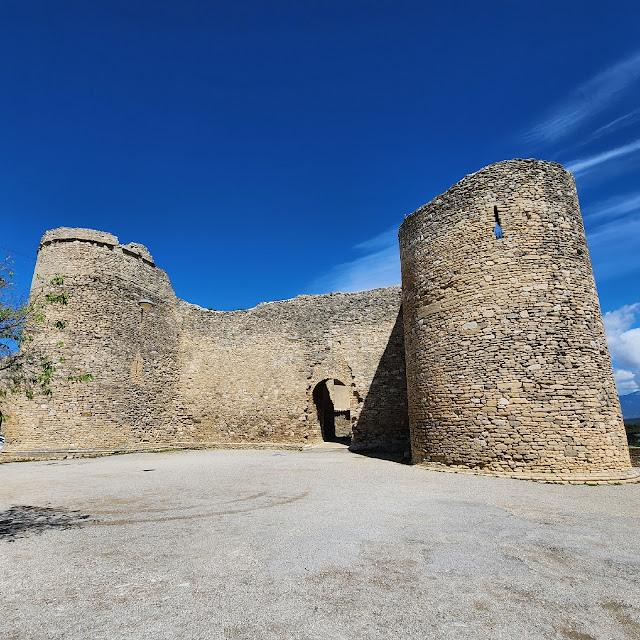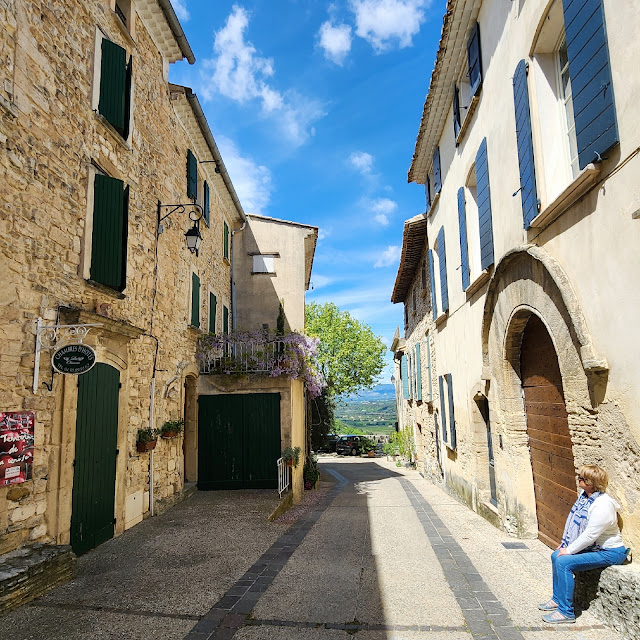We were invited to dine with Paul and Francoise Roumanille "chez Bruno" in Sablet on a recent Friday. As I told you in this
post, Paul and Francoise and their parents before them have been making wine in Sablet since 1939.
We got to talking during our lunch of traditional Aioli a la Morue, about what life was like for their families during WWII. Paul mentioned that there is a memorial to US airmen in Plan de Dieu, a large area planted in vineyards 11 km west of Sablet. Plan de Dieu translates to "God's Plain."
There are around 2620 acres planted in vineyards at an altitude of 100 meters within the Plan de Dieu AOC. Rather than one named village, the area includes the territories of Camaret-sur-Aigues, Jonquieres, Violes and Travaillan. A few patches of woodlands dot the expanse of vines.
Soil is mainly red clay packed with rounded cobblestones. There is not a lot of soil matter, so yields are modest, barely enough to produce one bottle of wine per plant. The wines are all red, made from the Cotes-du-Rhone's 3 leading grape varieties, Grenache, Syrah, and Mourvedre.
The next day, Saturday, we went out to find this war memorial to US airmen. We see war memorials in almost every village in Provence dedicated to the children of the town who died serving their country in WWI or WWII. We have never seen a war memorial to US military personnel other than near where troops landed on D-Day in
Normandy.
Paul said the memorial was on the road to Cameret-sur-Aigues just beyond the turnoff to Cairanne. Sure enough, as we were driving on the D23 toward Camaret-sur-Aigues, we came to a small road going off to the right with a small white sign "war memorial".
 |
| War memorial to US airmen who died in Plan de Dieu |
There is not a lot of information at the memorial or on the internet about the events that occurred over the Plan de Dieu that inspired locals to build this memorial.
 |
| You can see the vast plain of vineyards to the west of the war memorial |
At first glance, the site is unremarkable. Set in the middle of a vast plain of vineyards, the simple stone monument is set just off the side of a one-way dirt road.
 |
| The memorial is festooned with flowers and red, white and blue ribbons |
I found that on Saturday, April 16, 2005, approximately 200 French men and women along with French and American military representatives gathered during an icy spring rainy day to dedicate the new memorial to the five P-38 Lightning pilots who died while attacking nearby airfields.
2005 was the 60th anniversary of the liberation of France. The locals thought it necessary to express their appreciation with this memorial stone to the young pilots for their dedication in the darkest hour of French history, and active participation in the liberation of France and victory over Nazi Germany.
Three of the honored pilots went down on June 15, 1944, trying to weaken German defenses for the Allied assault of southern France that would follow the Normandy invasion. 2nd Lt. Hugh Crandall Jr. and 1st Lt. Harold V Duggleby from the 94th Fighter Squadron were both brought down by anti-aircraft fire on strafing runs against the Orange-Plan de Dieu airfield.
At about the same time, 1st Lt. Warren E. Semple from the 49th Fighter Squadron was shot down by a German pilot while strafing the nearby Orange-Caritat airstrip.
Several weeks later in early August, 2nd Lt. Robert D. Simpson of the 48th Fighter Squadron and 2nd Lt. A. Tracy of the 49th Fighter Squadron were downed by flack and killed on similar missions. Watching the attacking planes get shot down was shocking for those on the ground said one of the local residents who was 11 in 1944.
 |
| Listing of the names of the 5 young US airmen who died in Plan de Dieu. |
Across the narrow country road from the war memorial, there is the Bergerie du Bois des Dames. The name Bois des Dames (wood of the ladies) comes from the thick oak woods and pastures that once covered part of this area. The woods belonged to religious ladies who had retired to a high valley in the hills of Gigondas, at the convent of Prebayon, hence the name Bois des Dames.
 |
| Bergerie du Bois des Dames |
I couldn't find any information about this bergerie. I do know that bergeries are enclosures that shepherds used in old times to contain and protect their sheep. In the picture below, you can see in the corner of the bergerie, the remains of a very deep well.
 |
| Interior of the Bergerie du Bois des Dames. |
In the picture below, you can see where the water came out from the well into a water trough that delivered it into a basin for the sheep.
 |
| Trough for water to run from well into the water basin |
The next time we are in Sablet, I will go to the Domaine Bois des Dames and see if anyone there can tell me why the memorial and bergerie are located on different sides of the country road. I would also like to find out the age of the bergerie structure. It looks old, so I assume it is but sometimes looks as we know can be deceiving.
As I have told you several times. we frequently see pilots of the Patrouille de France, the French precision flying unit, practicing their stunts over this area. So sobering to think, while we get such enjoyment from seeing the Patrouille flying overhead, there was a time in the last century when the planes flying overhead were engaged in serious, deadly warfare.



































































